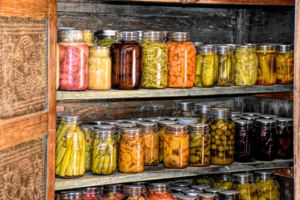8 Practical Tips for Frugal Preparedness
Sometimes we find ourselves in a time where frugal preparedness is important. However, the misconception that preparedness comes with a hefty price tag can be discouraging for those on a tight budget. The truth is, you can be well-prepared without breaking the bank. This article will explore practical tips for frugal preparedness, demonstrating that even the most budget-conscious people can safeguard their families and themselves in times of crisis.
-
Start with a Plan
Your first step to budget-friendly preparedness is to create a plan. Identify potential risks in your area, whether it’s severe weather, power outages, or economic instability. Consider the specific needs of your family, such as dietary restrictions or medical conditions, and establish clear goals. Having a plan in place will help you prioritize your efforts and budget, ensuring you’re addressing the most relevant concerns.
Pro-tip: Make an envelope, jar, or other savings system, and put $5, $10, $20, or whatever amount factors into your budget aside each pay towards your emergency plan!
-
Emergency Kits
Building an emergency kit doesn’t have to be expensive. Begin with the essentials: water, non-perishable foods, a flashlight, batteries, a first-aid kit, and a warm blanket. Start small and gradually expand your kit by adding items during sales and discounts. Check out our emergency kits to get you started.
-
Couponing and Sales
The art of couponing can be a budget prepper’s best friend. Scour your local newspapers, online coupon websites, or manufacturer websites for deals on non-perishable items. You’d be amazed at how much you can save on products ranging from canned foods to hygiene supplies. And don’t forget to keep an eye out for store ends for extra discounts and promotions.
-
DIY Preparedness
Many preparedness items can be crafted at home, which can be both cost-effective and rewarding.
- Water Purification Methods: Instead of purchasing water filters or purifiers, learn how to make your own. DIY water purification methods, such as constructing a simple solar still, can provide you with safe drinking water during an emergency. Do thorough research for you and your households safety!
- Emergency Lighting: Create your own emergency lighting options. For example, make inexpensive oil lamps or candles from items you already have at home. You can craft simple oil lanterns from mason jars, wicks, and vegetable oil.
- Homemade Fire Starters: Consider making fire starters from items like cotton balls soaked in petroleum jelly, cardboard egg cartons filled with dryer lint and wax, or DIY fire starter sticks made from sawdust and paraffin wax.
- Food Preservation: Explore food preservation methods like canning and vacuum sealing. These techniques can help you store and preserve your own food for emergency use.

- Gardening: If you have a garden or access to outdoor space, consider starting a garden. Planting your own vegetables and herbs can reduce your reliance on store-bought food during an emergency or provide a way to grow your own produce to can/preserve yourself.
- Rainwater Harvesting: Install a rainwater harvesting system to collect and store rainwater for non-potable uses like flushing toilets, watering plants, or cleaning. Building a DIY rain barrel system can be cost-effective and eco-friendly.

- Second-Hand Gear: Thrift stores, garage sales, and online marketplaces are goldmines for finding gently used outdoor gear, clothing, and camping equipment at a fraction of the cost of new items. Look for durable, well-maintained gear such as backpacks, sleeping bags, and sturdy footwear. Your budget will thank you.
-
Education is Key
Investing time in learning essential skills can be just as important as accumulating supplies. There are plenty of free or low-cost courses available, both in person and online. These courses cover topics like first aid, wilderness survival, and emergency communication. For example, you can often find CPR and basic first aid classes offered through your workplace, by local organizations or online.
-
Prioritize Essentials
When budgeting for preparedness, prioritize the most critical items first. Water, food, and a means of staying warm should be your top concerns. Start by stockpiling water by picking up an extra jug or bottles each grocery trip. then build a small stash of non-perishable foods, starting with the basics like rice, beans, canned vegetables, and pasta, again picking up an extra each grocery shop. As your budget allows, add additional items like tools, communication devices, and first-aid supplies.
-
Group or Bulk Purchases
Consider joining forces with friends or neighbors to make bulk purchases. Buying in larger quantities can often secure lower prices per unit.
Conclusion
Prepping on a budget doesn’t mean compromising your safety and that of your loved ones. With a well-thought-out plan and strategic choices, you can achieve preparedness without straining your finances. Remember, it’s the determination and resourcefulness of individuals that make them truly prepared, and this holds true regardless of the budget constraints. Sensible, cost-effective preparedness is an empowering journey toward resilience, and it’s within reach for everyone. By being mindful of your budget and making smart choices, you can confidently navigate the uncertainties of life and ensure you’re well-prepared for whatever challenges may come your way.




